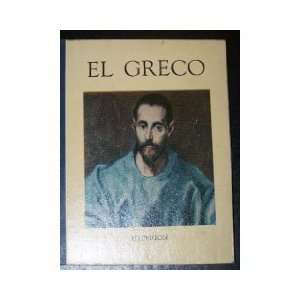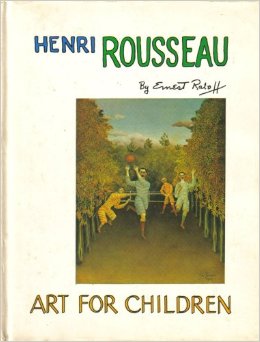

Tracey Campbell Pearson thinks her beloved lost book (which had a cover like this) might have been from the Hyperion Miniature Art Book Series, published in the late 1940’s or 1950’s.
My own nephew, as a little guy, was predictably fond of books about trucks and construction sites and other typically popular young-boy fare. But for his fifth birthday, he didn’t want a celebration featuring construction vehicles or pirates or ninjas or superheroes. Instead, he insisted on hosting an Andy Goldsworthy party. He’d become fascinated with the artist’s outdoor constructions in a book on his moms’ coffee table, which led them to the fabulous Rivers and Tides documentary about Goldsworthy’s work. So — in late February, in snowy cold Vermont — a bunch of little boys and girls bundled up in snowsuits and mittens and went out into the backyard to make snow and ice structures. It was pretty great.

When I was a school librarian in New York City, there was a kindergartner who used to spend hours looking at old photography books of the city. He was particularly fascinated by the trains running through the city, and the layout of the streets. This boy and his dad went on walks through the city, finding and tracing remnants of long-lost train tracks. One day, Griffin was looking at a spread in one of the big old books with sepia photographs. I think it was an aerial view, but not from too high up. (I can’t remember which exact streets he identified, so they are indicated with “XX” in the following quote.) Griffin said, musing, “I think this must be the intersection of XX Avenue and XX St., because XX Avenue went in both directions back then, but XX St. was one way, and there are train tracks behind here.” We flipped to the photo credits section and sure enough, he was right. I may not remember any of the street names he mentioned, but I sure remember being astonished at his patient assessment of the photographs and his thoughtful deductive analysis.
Now, I am fairly certain that, were a customer to ask me for a great recommendation for a three-year-old, and I handed her The Art of El Greco (or, for a five-year-old, some Andy Goldsworthy or a book of old Manhattan photos), I would encounter some pretty skeptical looks. Rightly so. But the truth is, we never know what will reach into a child’s heart and soul and imagination and take root. This is why it’s so valuable and important to expose children to all kinds of books, to give them not only children’s books, but interesting books for older readers — coffee table books of art and people and far-off places — and have them in our homes, our doctors’ offices, our libraries and DMVs and everywhere little kids hang out without a lot to do — readily available. And it behooves us to do our best to get those books into homes that can’t afford them.
 Something else I take from these anecdotes is a reminder that nonfiction is just as important for very little children as for older independent readers. I need to remember that when I’m hand selling books to parents and grandparents. I’m not sure El Greco would ever have occurred to me to recommend, but I do remember loving a wonderful children’s art book series my parents gave me one volume at a time. My favorite was the one on Henri Rousseau. I lived in its pages. (A quick Google search led me right to it: Ernest Raboff’s “Art for Children” series, once published by Doubleday, now OP. Yoo hoo, Random House!)
Something else I take from these anecdotes is a reminder that nonfiction is just as important for very little children as for older independent readers. I need to remember that when I’m hand selling books to parents and grandparents. I’m not sure El Greco would ever have occurred to me to recommend, but I do remember loving a wonderful children’s art book series my parents gave me one volume at a time. My favorite was the one on Henri Rousseau. I lived in its pages. (A quick Google search led me right to it: Ernest Raboff’s “Art for Children” series, once published by Doubleday, now OP. Yoo hoo, Random House!)
Really, it makes sense. Most children are visual creatures; there’s a reason the earliest books are picture books. Art and photography books are, after all, picture books – albeit of a different kind. They introduce children to worlds beyond their experience, both real and imaginary, sparking imagination and, perhaps, lifelong passions.
Readers, what unexpected book obsessions did you have as a child, or have you encountered with the kids in your lives?

This is wonderful, and so true. We have tons of art and architecture books around the house (including Andy Goldsworthy!) and they have played a big role in my children’s visual education. And now that my kid’s are teenagers, each has a most discerning eye when it comes to picture book art!
I think the lesson I learned is the benefit of having several types of books around the house! With the popularity of Percy Jackson, I’ve been telling kids about my favorite book:The D’Aulaires’ book of Greek Mythology. My sister and I read through that book so much that the pages all fell out, and we carried it around in an old Garfield folder and STILL read it! When I was in college, I found a copy in a book order and immediately ordered it and proudly brought it home to my sister, so we could have it whole again.
My sister and I loved (and similarly read to tatters) D’Aulaire’s Book of Greek Myths, too! It’s a staple at the Flying Pig. (One of the joys of opening the bookstore was stocking it with every book I adored as a child – at least the ones that are still in print.)
I loved this, Elizabeth! It is unbelievably true… especially when thinking of our reluctant readers out there. Exposing them to all sorts of books – showing them that there are books about things they will like – is exactly what encourages a life-long love of reading and critical thinking.
I used to drag around my mother’s Readers Digest magazines. I carried them everywhere from the age of 2 to the age of 4 (when I got Simba for Christmas!).
Thanks for this insightful article.
For me, it was Wuthering Heights. I was so young when I first read it, I didn’t understand all the words and some — those written in dialect — I couldn’t even look up in the dictionary. But I loved the characters and that it had been written more than 100 years before I was born. I re-read it every few months and must have read it a hundred times before I was 12. Just recently, I re-read it again, and it still drew me in to that other century, just as it did all those years ago.
I have a photo of myself, age 4, crouched over the World Book Atlas, which my mother used to prop up against the couch cushions because it was too big for me to hold open. I especially loved the historical maps section.
My niece permanently borrowed my books of Escher drawings when she was 3; she would beg my brother to visit me, then roll under the coffee table with that book and stare at it for an hour. After a dozen such visits, I finally loaned it to her, thinking it would come back in a few weeks, but she still retreats into a corner with that book when she’s had a rough day in middle school.
I read books such as the Ramayana and La Morte D’Arthur in 3rd grade. I actually read any kind of mythology I could get my hands on at school and at the base library (we lived in Japan at that time).
I loved oh so many books I was not supposed to when I was young. Was called out by my eighth grade nun for reading Is Paris Burning? (loved it!) during math. And I so remember a young boy, maybe 4, when I was visiting The Red Balloon bookstore to promote my book CHI-HOON.. The book is about a young Korean girl and as on many other visits, I was delighted to see so many Korean adoptees had come to hear me speak. And this one very enthusiastic young boy. Who clapped very loudly when I was introduced. Who interrupted me whenever I gave some fact about the book with a loud “I know! I know!”. I finally had him come stand next to me and hold the book so that I could get a few sentences out. He beamed and nodded with approval at everything I said. He hugged me at the end. His mother explained it was his “absolute best book.” He was not Korean. He had no Korean relatives or connections. He shrugged when I asked why he loved the book. He just did. Bless his heart.
Isn’t that great about the little boy? You just never know which books will speak loudly to a child. (And wow, I loved Is Paris Burning? – but discovered it as an adult. Now you’re making me think my almost-15-year-old nephew might love it.)
Wonderful, Elizabeth. Thank you! I remember being captivated and a little frightened by a children’s book of the Bible, beautifully bound, with fine full-page illustrations protected by thin paper.
My eldest son, now 17, stumbled across a book about the Titanic when he was in pre-school. That seed sprouted into a real passion for everything Edwardian: steamships, zeppelins, architecture, politics, art history, … Other books along the way were like gasoline on a fire.
When I was in 4th grade I discovered The Count of Monte Cristo, and devoured it. And then it was on to the Prisoner of Zenda and the Three Musketeers. I loved those books so much, although I’m sure I must have missed a lot. I should re-read them!
Yet another argument for having a variety of real books around the house. I wonder if, 20 years from now, adults will experience nostalgia for websites and apps they visited as preschoolers.